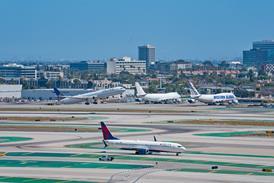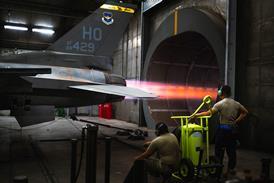ALAN DRON
While the world business jet market will continue to grow over the next decade, ironically one of the few developments that could dent it would be if airlines follow United's lead and buy large numbers of executive aircraft themselves. These are two of the predictions for the business jet market from US forecaster Teal Group, which also believes that Boeing's planned Sonic Cruiser could have a major impact on the market.
Peering into the future, the Fairfax, Virginia-based forecaster believes high-end aircraft will account for more than 45% of its market value in the next decade. This will make Bombardier and General Dynamics (with its Gulfstream and Galaxy products) the two main players in the market, says Teal, with Raytheon potentially the weakest player in the field.
In its 11th annual Business Aircraft Overview, the group's director - aviation, Richard Aboulafia, foresees a total of 6,896 business jets being produced from 2001-2010, worth $94.4 billion in 2001 dollar terms. This would represent a 70% increase over the $54.3 billion in deliveries over the preceding decade.
The market for business jets suddenly expanded in the mid-1990s after many years of relative stagnation at around $2-3 billion annually to $6.1 billion in 1997 and $10.7 billion last year, and Aboulafia sees few signs of the bubble bursting.
Downturn
Although he predicts there will be a modest downturn from now until 2005, even "the worst year in our forecast will be better than any year prior to 1999".
The business aircraft market expanded in the late 1990s for several reasons, says Aboulafia. These included the main external market driver, corporate profits, rising sharply and a change in the business world's attitude toward business aircraft. These were no longer seen as executive toys, but useful tools for maximising executives' productivity.
"Corporate jets, therefore, are now held in high esteem due to what might be termed a 'cult of productivity', a belief that economic progress lies with more efficient use of capital and labour resources," says Aboulafia. This sentiment is particularly strong in North America, which remains the main market for business aircraft.
Another factor in the booming business aircraft market was the influx of no fewer than 15 new business jet models between 1995-99, together with the booming fractional jet ownership market. These have resulted in some major orders, but fractional ownership is a double-edged sword, says Aboulafia.
Firstly, the buying power of fractional jet operators means they can demand discounted prices, pushing down manufacturers' profit margins.
Example
And, if more airlines follow the example of the US's United Airlines and buy huge tranches of business aircraft to elbow their way into the fractional market, that will provide orders for business jet manufacturers, but also further depress their profit margins.
Airbus believes the A380, with its cavernous interior, will attract executives back to the airlines, says Aboulafia, but he doubts it. No matter how large the aircraft, executives will still have to fight their way through crowded airports, which is a major turn-off.
Successful
Boeing's tactic to woo executives is by providing greater speed with its proposed Sonic Cruiser and Aboulafia believes this will be more successful than the A380: "It may not be enough to take back all the market gained by business jets, but it will certainly help redress the balance. "Sonic Cruiser would be faster than any of today's business jets. It will have style and prestige on its side as well, which always appeals to high-end travellers.
"Turning to individual manufacturers, the report says Bombardier and General Dynamics are likely to be top dogs in the next decade's market, averaging 25.4% and 25.1% respectively of the market. This is due to Bombardier's "bullish new model development, most notably with the Global Express" and to General Dynamics' acquisition of Gulfstream and now Galaxy. Teal believes that GD will do particularly well in selling special mission aircraft to governments and air arms, and suggests that Sino-Swearingen, with its small SJ30 jet, could make an attractive further acquisition, allowing GD to round out its range of products.
The report says Cessna's ability to 'mix and match' fuselages, engines and wings to produce a powerful line-up of products will give it an average 17.2% market share. Dassault¹s rejuvenated range will boost its prospects to 18.9% of sales. It also suggests that Dassault could ally with Brazil's Embraer.
Aboulafia says Raytheon will be the weakest player with around 9.6% market share. Although it is adding three new models (the Hawker Horizon, Premier One and Hawker 450) which will help its prospects, "the lack of a high-end machine will restrict Raytheon's market share growth".
Source: Flight Daily News




















